|
|
|
|
CIAO DATE: 6/99
Conflict-Cooperation for Interstate and Intrastate Interactions: An Expansion of the Goldstein Scale *
Charles Lewis Taylor
Virginia Polytechnic Institute and State University
Joe Bond
Harvard University
Doug Bond
Harvard University and
the Center of Excellence in Disaster Management
and Humanitarian Assistance, Tripler AMC
J. Craig Jenkins
The Ohio State University
Zeynep Benderlioglu Kuzucu
The Ohio State University
International Studies Association
40th Annual Convention
Washington, D.C.
February 16–20, 1999
Abstract
This paper presents the current state of our project to expand and to replicate Goldstein’s Conflict-Cooperation Scale for WEIS Event Data using a Delphi technique and focusing on intrastate as well as interstate interactions. We report here the results of a pilot study conducted with the assistance of a small expert panel. Our intention is to take advantage of a larger and more diverse set of judges representing the governmental, national security, commercial and academic communities while controlling for major demographic characteristics. In our Integrated Data for Event Analysis (IDEA) approach, classic WEIS categories are supplemented with verb cues drawn from the World Handbook and other interaction event taxonomies. Panelists are asked to rank these event categories, with regard to contention-accommodation, coercion-altruism, and physical violence as well as to overall conflict-cooperation. No a priori assumptions are made with regard to the three hypothesized dimensions and their fit or placement within the conceptual space of conflict and cooperation. Interrelationships will be sought empirically. This expansion of the Goldstein scale will be a useful tool in the analysis of conflict and cooperation in international and intra-national political interactions.
Introduction
Political conflict and cooperation involve actors of many kinds. Individuals may act alone, by writing an angry letter to a politician, for example. They may also reinforce one another in groups of some kind perhaps while protesting reductions in government stipends for students. Components of government may be in conflict with one another; parliamentary debates are a form of political conflict. And governments may have reasons to cooperate or to engage in conflict with one another. Interstate politics is conflict that involves whole states as actors, in actions ranging from consultation and emergency aid to border disputes and military invasion.
This multiplicity of event types overlaid with a preponderance of actors and arenas produces difficulty for comprehensive and precise analysis. Not all events of conflict are equally intense in intention or execution or equally significant to a final outcome. Nor are all efforts at cooperation of the same generosity or success. How does one most appropriately transform simple counts of day by day reports of who did what to whom, when and how into indexes of behavior that can be easily employed for analytical purposes?
The Conflict-Cooperation Scale for WEIS data, developed by Joshua S. Goldstein (1992), has become a standard tool used by scholars in the analysis of interstate event interaction data. Goldstein surveyed eight of his colleagues asking them to assign weights to 61 different types of events in order to obtain a weighted aggregation of these events. The original categories of the World Event Interaction Survey (WEIS), as developed by David McClelland (1969) were not intended to produce either interval or ordinal data. The obvious utility of cooperation and conflict scales for analysis of interstate interactions nevertheless engendered efforts to create measures that could be used for more efficient comparisons among states over time. Goldstein’s scale, however, was essentially constructed with interstate events in mind. Non-state behavior is probably increasing in importance and is certainly receiving more attention among scholars interested in political conflict and cooperation. We also need a set of scales that can be used to measure intrastate conflict and cooperation.
Our project, Integrated Data for Event Analysis (IDEA) creates for the first time a comprehensive catalogue of exchanges between states and among actors within states. In the past, research projects have measured conflict and cooperation, but each project has tended to concentrate either on action within states or action among them. Undertakings such as the World Handbooks of Political and Social Indicators (Taylor and Jodice 1983), Polity I, II and III (Gurr, Jagger, Moore 1990), and Dimensions of Nations (DON) (Rummel 1963) were directed toward government change and societal interactions within individual political systems. WEIS, the Correlates of War (COW) (Singer and Small 1993) and Conflict and Peace Data Bank (COPDAB) (Azar 1982), on the other hand, examined interstate interactions for patterns of conflict and cooperation. Unlike these earlier projects, IDEA assumes basic similarities between conflict and cooperation within states and conflict and cooperation between states. We believe a set of scales can be developed for use with both arenas of conflict and cooperation. Data series, therefore, are patterned upon categories of WEIS (McClelland 1976), the World Handbooks (Taylor and Jodice 1983), Protocol for the Assessment of Nonviolent Direct Action (PANDA) (Bond and Bond 1998), Intrastate Political Interactions (IPI) (Davis, Leeds, Moore 1998), Militarized Interstate Disputes (MIDS) (Jones, Bermer, Singer 1996), and Olzak’s (1998) social movement research. Only actors and targets will distinguish intrastate from interstate events.
Dimensions of Conflict and Cooperation
Relationships between two individuals, groups, or states can be hypothesized to fall along a continuum ranging from unmitigated conflict to complete cooperation. Goldstein notes that this continuum refers to “the affect or tension implicit in a series of actions taken by one nation toward another during a period of time.” His panel of judges specified “the amount of cooperation or conflict thought to be conveyed typically by a type of event such as verbal criticism or military attack” (Goldstein 1992:370). Cooperation then involves a joint effort or operation for the forwarding of mutual benefits. These may be either short or long term in nature. Conflict, on the other hand, involves antagonism, contradictory action, or disagreement. Interests are perceived to be subject to a zero-sum game.
We believe that it may be possible to break cooperation and conflict down into their components. For example, some behavior is not violent and yet it is not quite cooperative. We believe that it is important to make the empirical test for collinearity. We hypothesize one uni-directional and two bi-directional dimensions: physical violence, (contention-accommodation, and coercion-altruism, respectively. Political actions by state and non-state actors may be said to evince varying positions along these dimensions. Unlike the Goldstein scale, our quest makes no assumption with regard to collinearity. Contention may or may not be accompanied by nonviolent coercion or by physical violence. When physical violence is present, it may be the action of the original actor or it may come as a response to that actor by others. Contention may indicate, especially when accompanied by low levels or absence of violence, the management of significant conflicts of interests that requires little coercion on the part of either the state or the competing groups within the society. Hence, neither coercion nor violence alone can be used as a measure of stability, since contention can undermine the status quo even without overt clashes in the street.
Contention is an act that is disruptive. In the World Handbook of Political and Social Indicators, such action was called “irregular.” It is the alternative to the normal, routine processes for resolution of conflict in a society. Accommodation, on the other hand, implies mutual dependence and cooperative action. It follows a pattern that is expected. It is frequently termed normal, routine or regular. The distinction between routine and disruptive can be ambiguous and context specific. Strife, protest and turmoil can become normal means of politics (just as some individuals can be expected to be confrontational in style). Disruption depends upon uncertainty. Those against whom popular action is directed cannot be sure of the intent of the actors. Non-violent direct action, for example, is effective when it is innovative and catches its target off-guard. Accommodating action stresses mutuality and the sharing of interests.
Coercion is the imposition or the threat of the imposition of negative social, economic, political, or physical sanctions for the purpose of effecting compliance. Violence is one, but only one, means of coercion. Contention or perceived contention may be met by coercion to maintain the power of the elite, to order the common life, or to stabilize the economy. Coercion, whether violent or not, can be invoked by either state or non-state actors. As with contention, coercion can assume varying degrees of intensity. Actions that are both highly contentious and highly coercive give rise to conflicts that are most intense, whether they are violent or peaceful. Altruism implies an unselfish concern for the welfare of others and an unwillingness to constrain and compel them. That may be in short supply in politics, but long-term enlightened self-interest can sometimes stand in its place. As with contention and accommodation, coercion and altruism may be location and time specific.
Physical violence is measured best along a uni-directional dimension. While one might think of a continuum from complete peace to extreme violence, data do not get reported that way. Even so, as with contention and coercion, violence and its absence do not fall into a dichotomy. The degree of violence is not simply a matter of the number of events with destruction and casualties or even the amount of destruction or chaos brought about. More fundamentally, it has to do with the intensity of taking things into one’s hands and using physical force to change or to attempt to change them. Some actions indicate a greater vehemence of feeling than do others.
The Panel of Judges
Our goal is to include gender, ethnic, and age diversity in the panel of judges. Goldstein included some variation by gender and ethnicity; two of his eight judges were female and one was a member of a minority. We wish to broaden this variation. We would also like to include in the panel sociologists and political scientists from the civil government, the military, the commercial sector, and the academic world. To what extent do scholars and policy makers, for example, agree on an underlying understanding of a cooperative-conflictive continuum in politics? Replication is somewhat complicated here by the changes that have occurred in our post-1989 perception of the world. Changing mindsets could bring changes in the weights that are assigned. Goldstein’s study was done just after the fall of the wall but before the consequences of this event were fully integrated into our thought. The new perspectives argue, however, for the need for a reevaluation of the weights.
Results in this paper are based upon a slightly larger panel of judges than used by Goldstein. Of the 27 participants who were solicited, 12 completed the tasks of Phase I and eight finished Phase II. All of those who completed Phase II had previously completed Phase I. Due to time constraints, it is unclear whether all of those solicited actually received the request. At least two potential panelists had difficulty logging on to the web site. One panelist gave up out of sheer frustration. Several other participants expressed similar frustration although they did finish the task. Lack of time was often cited as reason for not being able to complete the ranking of events.
Of the 12 panelists who completed Phase I, eight hold PhD’s, two have finished all but dissertation, one holds an MA and one is in process of MA studies. Three are sociologists by training and the remainders are political scientists. Most of the latter are specialists in international relations. All of these participants have had at least some exposure to events data and content analysis. Three-quarters of them have worked extensively with events data. Among the three females and nine males were eight Americans, one Turk, one Bulgarian, one Norwegian, and one German. They are associated with the Ohio State University, Harvard University, Virginia Polytechnic Institute and State University, Memphis University, University of New Mexico, American University (D.C.), University of Colorado, Swiss Peace Foundation, and Yonsei University (ROK).
Six of the participants in Phase II were male and two were female. Except for one Turk, one Norwegian, and one Bulgarian, these panelists were American. Institutions represented included the Ohio State University, Harvard University, Virginia Polytechnic Institute and State University, University of New Mexico, American University (D.C.), University of Colorado and Yonsei University (ROK).
The panel was, therefore, not so diverse as we would have liked nor as we intend for the final scaling. Our purpose in this pilot study, however, was only to test our procedures and our web site in order to develop tighter logic, more comprehensive instructions, and smoother web site operation. This more developed set of procedures will then be employed with the larger and more diverse panel.
Instructions to the Panel
Each member of the panel was assigned a username and password for the IDEA web site. On the site itself, they were presented with a list of 128 types of events (See appendix). Each of these unique types describes a particular kind of interactive event within or between states. In Phase I, panelists were asked to place each event in numeric categories that would allow construction of scales to measure the degree of physical violence, as well as the placement along accommodation-contention and altruism-coercion continua. In Phase II almost a week later, they were requested to judge the relative placement of each event along a conflict-cooperation continuum. In each phase, weightings were stipulated both for state actors and for non-state actors.
For the first phase, the panelists were first directed to the physical violence dimension, and then in turn to the contention-accommodation and coercion-altruism dimensions. At the top of each page, three pop-up windows appeared, giving instructions specific to the dimension, descriptions of the dimensions, and a list of event types with descriptions of events that belong to each. Each panelist was asked first to click on the dimension descriptions in order to review the purpose of the dimension currently under consideration. After that, each was directed to the pop-up window containing instructions specific to the dimension and was asked to review these before proceeding. It was suggested that the individual instruction pages, dimension descriptions and event descriptions be printed for convenience and greater accuracy.
For the physical violence dimension, panelists were instructed to judge the relative placement of each event type with regard to extent of physical violence along this uni-dimensional scale first for non-state actors and then for state actors. The event types were presented alphabetically in the middle column, first with the prefix N- (non-state) and then with the prefix S- (state). Panelists then moved events (by holding down the event with a left mouse click and dragging them) into one of the boxes in either the non-state actor column on the right or the state actor column on the left. A brief description of an event was displayed as the cursor passed over that event. Panelists left entries that were not applicable to physical violence in the middle column. The point was to rank only events that were relevant to physical violence.
Panelists were asked to choose the event type that was most physically violent to place in box 10 of the scale. The remaining event types were to be distributed according to the level of violence the panelist would consider the type typically to imply. The scale was to be treated as a linear one, with 0 representing no violence and 10 representing the most violence. Panelists were also asked to rank items within boxes. As in the Goldstein study, panelists were asked to compare boxes 3 and 6, boxes 4 and 8, and boxes 5 and 10 to make sure that event types in the latter were about twice as physically violent as those in the former. They were encouraged to repeat the process as long as necessary and to make adjustments by moving event types from one box to another.
The panelist was free to leave the site before completing the decisions on each of the event types. Clicking the Submit button and exiting would assure that the work already accomplished would be automatically saved so that it could be added to or edited in the next session. Once all decisions had been completed, the panelist would notify the webmaster by e-mail.
Once the weights for physical violence had been submitted, the panelist was transferred directly to the page for accommodation-contention. Again the 256 events (half for non-state actors and half for state actors) appeared alphabetically in the middle column. Again panelists were requested to move event types by clicking on and dragging them to the appropriate category box in either the column for non-state actors or the column for state actors.
Unlike physical violence, however, this dimension was bi-directional. Categories ran from +5 (more accommodative) through +3 (moderately accommodative) and +1 (less accommodative) over 0 (neutral) through -1 (less contentious) and -3 (moderately contentious) to -5 (more contentious). All event types relevant to the dimension were to be placed in one of the 11 boxes. Those that were considered ambiguous went into the 0 category. Those not applicable to the dimension were to be left in the middle column. We wanted to identify relevant but ambiguous event types and keep them separate from inapplicable event types.
Panelists were asked to place the most contentious event type in box -5 and to distribute the remaining types into the other boxes according to how much contention the event was considered typically to imply. Again the scale was to be treated as a linear one, with -5 representing the most contentious act. Panelists were asked to compare boxes and make revisions as necessary. After decisions were finished, the panelist clicked on the Submit button to record the rankings. The page for altruism-coercion then appeared on the screen.
Once again, the 256 event types were listed alphabetically in the middle column. Altruism-coercion is also a bi-directional scale and its categories were labeled in a way similar to those of accommodation-contention. Event types whose placement was unclear were to be placed in the 0 category (ambiguous), but inapplicable entries were to be left in the middle column. The remaining event types were distributed among the categories ranging from +5 (more altruistic) to -5 (more coercive). Once all decisions were final and submitted, the first phase was at an end.
The second phase, undertaken by participants about a week later, produced weights for the same event types for the more general dimension of conflict-cooperation. The intention was to attempt an independent assessment that would allow comparison with the ranking separate constituent dimensions. Following Goldstein, the general dimension was also thought to be bi-directional. Panelists were asked to place the 256 event types into categories that ranged from +5 (more cooperation) through 0 (neutral) to -5 (more conflict). This was done for both state and non-state actors.
| Figure 1: Introductory Page to the Web Site |
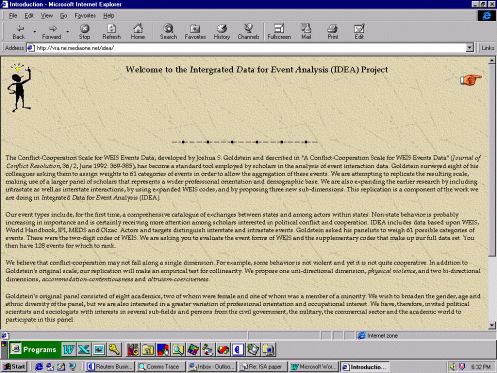
|
| Figure 2: Ranking for Altruism-Coercion |
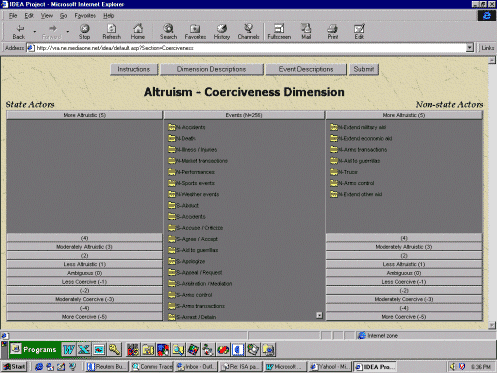
|
| Figure 3: Ranking for Conflict-Cooperation |
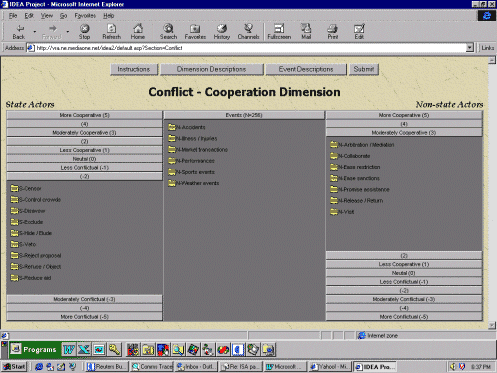
|
Agreement on the relative placement of events was not quite so high as Goldstein found nor so high as we would have liked. Of course, a test run to identify problems with procedures is unlikely to produce fine results. Several difficulties that we have identified are discussed in the next section of this paper. We believe that these can be rectified and that future runs will provide considerably more agreement among panelists.
Tables 1 - 4 give counts of the number of panelists who included each event type within each dimension of Phase I and in the overall dimension of Phase II. Also included are the means and standard deviations for each event type. Only event types included by at least four panelists (one-third of the total) appear here for Phase I. Event types included by at least three panelists (three-eighths) show up for Phase II. Standard deviations were also restricted to less than 1.5. The violence dimension is standardized and ranges from 0 to -5. All other dimensions range from +5 to -5. Tables 1-4 are sorted by the mean in ascending order followed by the event count, again in ascending order.
|
Table 1: Rankings by Panelists for Physical Violence
|
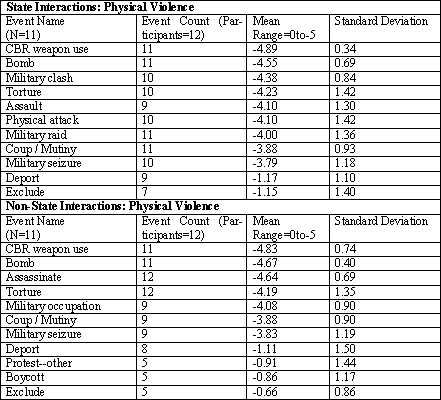
|
|
Table 2: Rankings by Panelists for Accommodation-Contention
|
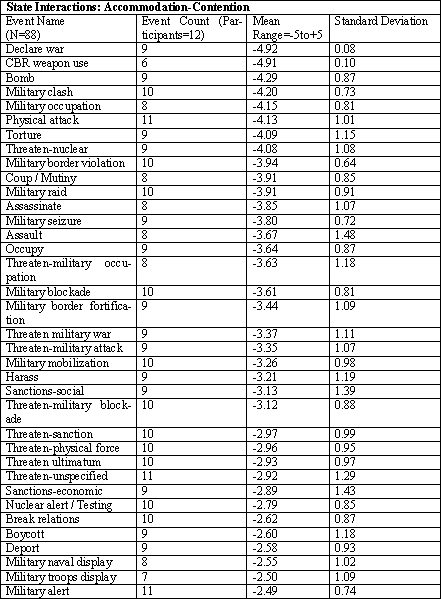
|
| Table 2. Continued |
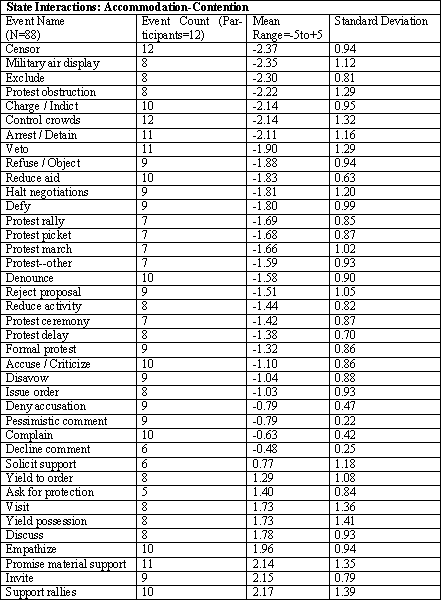
|
| Table 2. Continued |
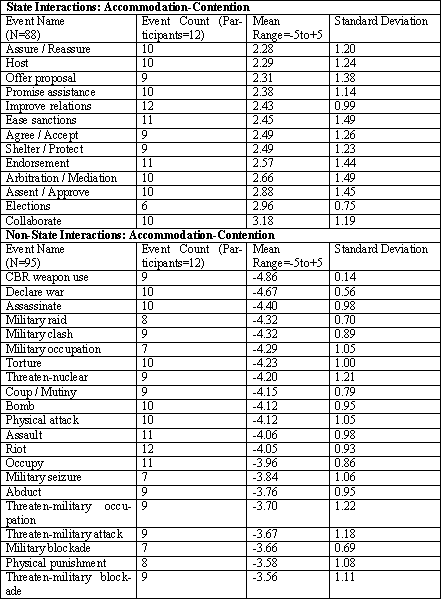
|
| Table 2. Continued |
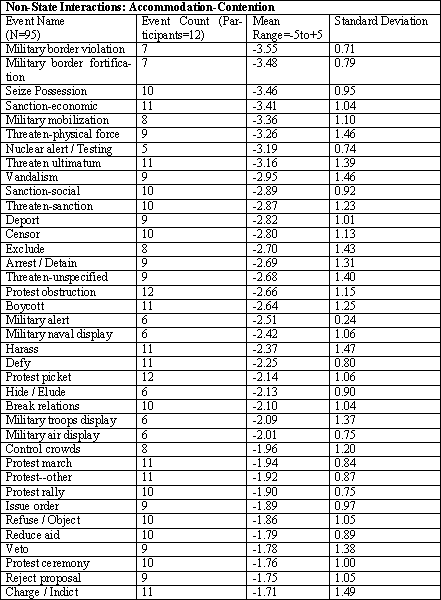
|
| Table 2. Continued |

|
|
Table 3: Rankings by Panelists for Altruism-Coercion
|
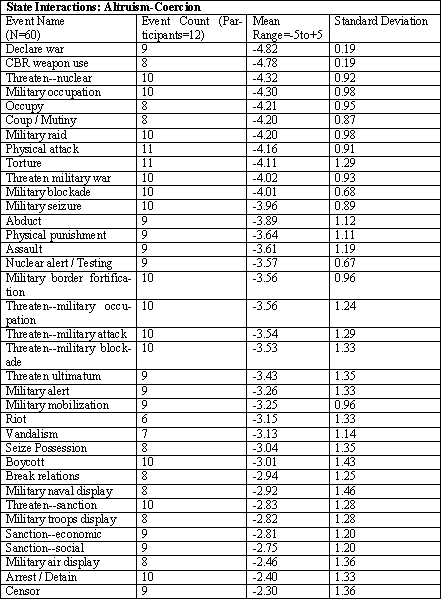
|
| Table 3. Continued |

|
| Table 3. Continued |

|
| Table 3. Continued |

|
|
Table 4: Rankings by Panelists for Conflict-Cooperation
|
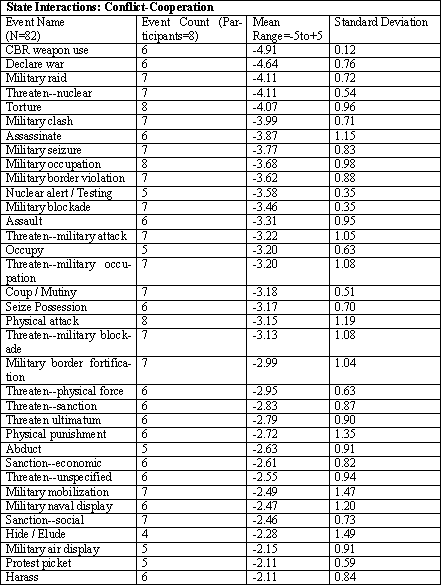
|
| Table 4. Continued |

|
| Table 4. Continued |
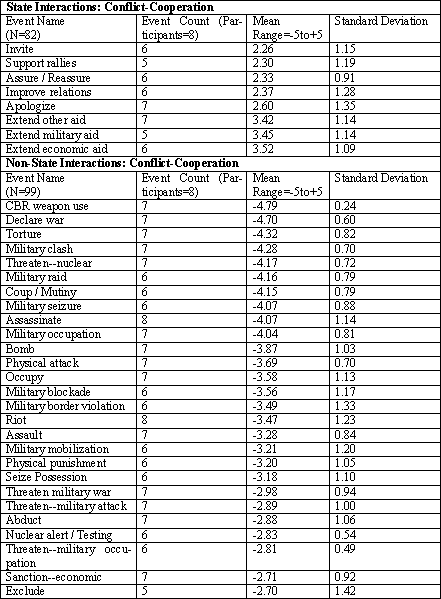
|
| Table 4. Continued |
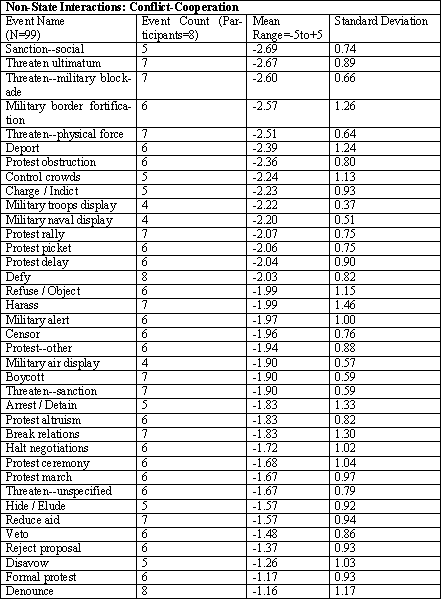
|
| Table 4. Continued |

|
Some Problems that Need Attention
The primary purpose for this pilot study was test our procedures and our web site in order to develop tighter logic, more comprehensive instructions, and smoother web site operation. This more developed set of procedures will then be employed with the larger and more diverse panel.
Most intense in its use of physical forceThen within each of these categories, further discrimination/ranking would be possible (and much easier since the decisions would be made in successive “cuts” and on a reduced number of event forms.
Moderately intense in its use of physical force
Somewhat intense in its use of physical force
Minimally intense in its use of physical force
Negligibly intense in its use of physical force
References
Azar, Edward E. (1982) “The Codebook of the Conflict and Peace Data Bank (COPDAB).” College Park, MD: Center for International Development, University of Maryland.
Conflict and Peace Data Bank (COPDAB): http://www.wisc.edu/dpls.cat/study/2840.html
Bond, Doug and Joe Bond (1998) “The Protocol for the Assessment of Nonviolent Direct Action (PANDA) Codebook.”
Protocol for the Assessment of Nonviolence Direct Action (PANDA) : http://hdc-www.harvard.edu/cfia/pnscs/panda.htm
Davis, David R., Brett Ashley Leeds and Will H. Moore (1998) “Measuring Dissident and State Behavior: The Intranational Political Interactions (IPI) Project,” paper presented at the Workshop on Cross-National Data Collection, Texas A & M University (November 21).
Intrastate Political Interactions (IPI): http://garnet.acns.fsu.edu/~whmoore/ipi/ipi.html
Goldstein, Joshua S. (1992) “A Conflict-Cooperation Scale for WEIS Events Data,” Journal of Conflict Resolution, 36/2 (June), pp. 369-385.
Gurr, Ted Robert, Keith Jagger, and Will H. Moore (1990) “The Transformation of the Western State: The Growth of Democracy, Autocracy and State Power Since 1800,” Studies in Comparative International Development, 25 (Spring), pp. 73-108.
Polity I and II: http://www.colorado.edu/IBS/GAD/spacetime/data/Polity.html
Jaggers, Keith and Ted Robert Gurr (1996) “Polity III: Regime Type and Political Authority, 1800-1994.” (ICPSR 6695) Ann Arbor: Inter-University Consortium for Political and Social Research.
Jones, Daniel M., Stuart A. Bremer and J. David Singer (1996) “Militarized Interstate Disputes, 1816-1992: Rationale, Coding Rules, and Empirical Patterns,” Conflict Management and Peace Science, 15/2, pp. 163-213.
Militarized Interstate Disputes (MIDS): http://pss.la.psu.edu/MID_DATA.HTM
McClelland, Charles A. and G. D. Hoggard (1969) “Conflict Patterns in the Interactions Among Nations,” International Politics and Foreign Policy: A Reader in Research and Theory (ed.) J. N. Rosenau. New York: Free Press, pp. 711-724.
McClelland, Charles A. (1976) World Event/Interaction Survey Codebook. (ICPSR 5211) Ann Arbor: Inter-University Consortium for Political and Social Research.
Olzak, Susan (1998) “Ethnic Protest in Core and Periphery States,” Ethnic Racial Studies, 21/2 (March), pp. 187-217.
Rummel, R. J. (1963) “Dimensions of Conflict Behavior Within and Between Nations,” General Systems Yearbook, 10. Bedford, MA: Society for General Systems Research.
Dimensions of Nations (DON): http://www2.hawaii.edu/~rummel/DIMENSIONS.HTM
Singer, J. David and Melvin Small (1993) The Correlates of War: Data File. Ann Arbor: University of Michigan Press.
Correlates of War (COW): http://www.umich.edu/~cowproj/index.html
Taylor, Charles Lewis and David A. Jodice (1983) World Handbook of Political and Social Indicators: Third Edition. New Haven: Yale University Press.
Taylor, Charles Lewis and David A. Jodice (1983) World Handbook of Political and Social Indicators Codebook. (ICPSR 7761) Ann Arbor: Inter-University Consortium for Political and Social Research.
Appendix
|
Event Types and Their Descriptions
|
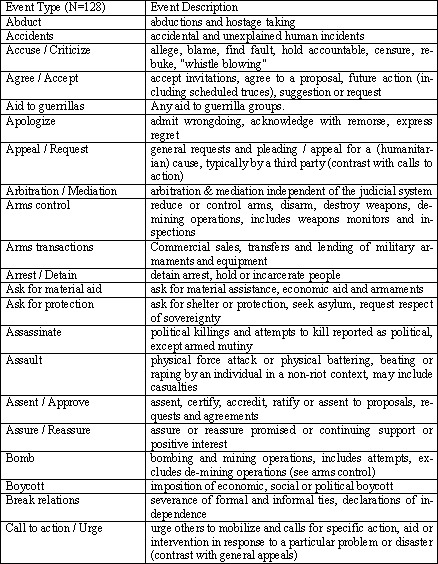
|

|
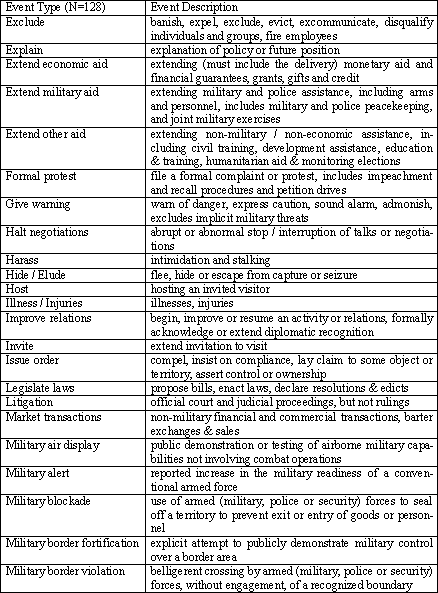
|
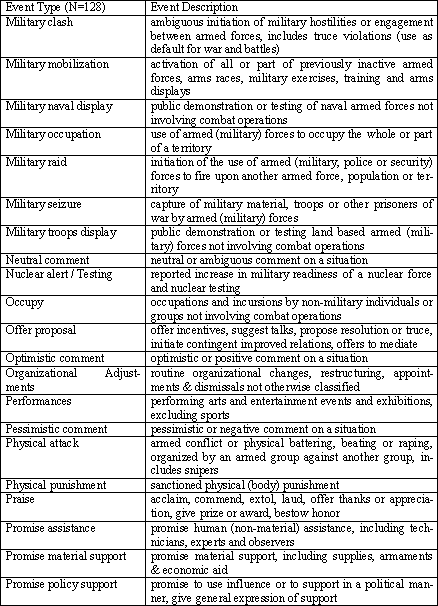
|
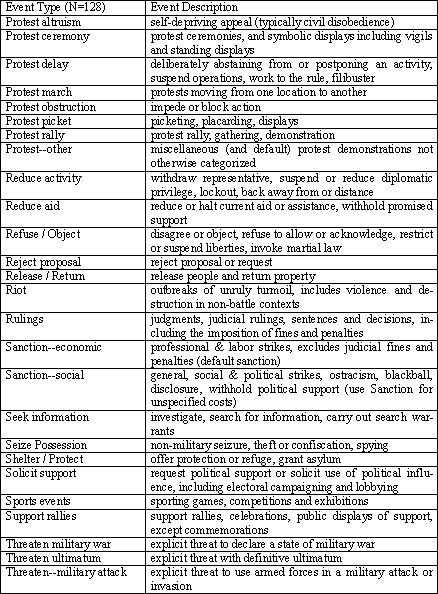
|
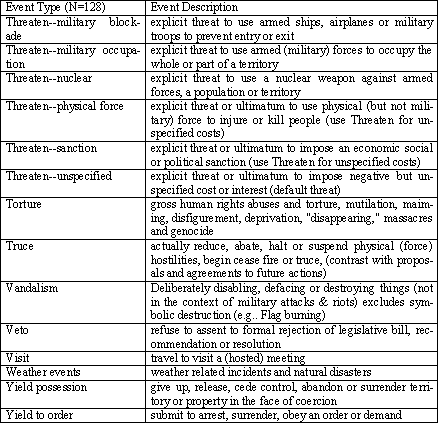
|
Endnotes
*: This paper was prepared for presentation at the annual meeting of the International Studies Association, Washington, D.C., February 20, 1999. The research was supported by funding from the National Science Foundation (SBR-971095) and the Center of Excellence (ISS-12088), neither of which bears any responsibility for the views expressed. Back.